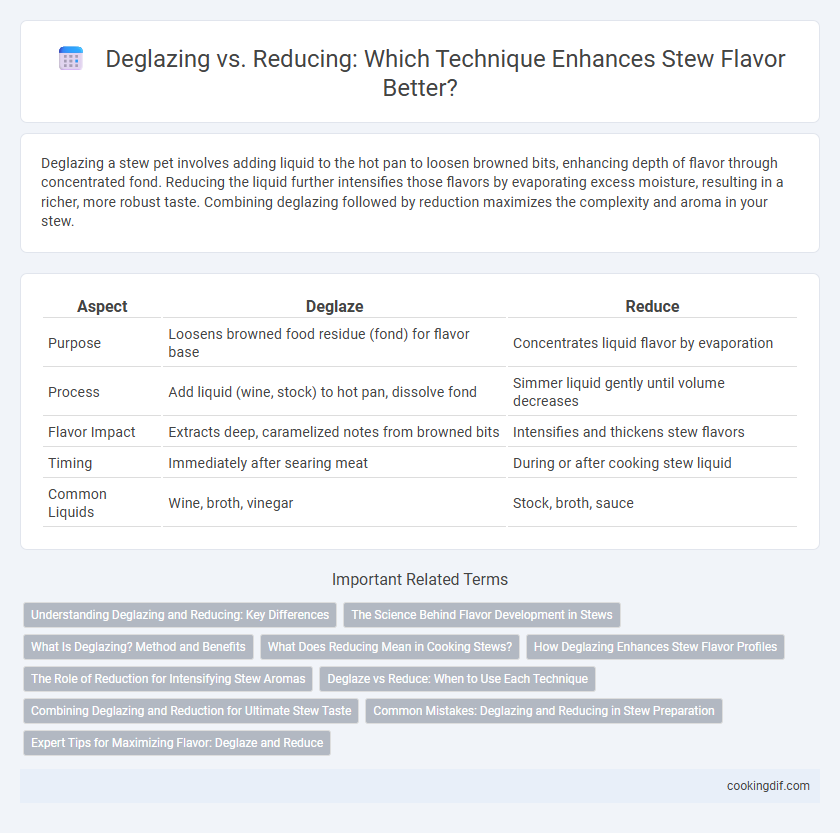Deglazing a stew pet involves adding liquid to the hot pan to loosen browned bits, enhancing depth of flavor through concentrated fond. Reducing the liquid further intensifies those flavors by evaporating excess moisture, resulting in a richer, more robust taste. Combining deglazing followed by reduction maximizes the complexity and aroma in your stew.
Table of Comparison
| Aspect | Deglaze | Reduce |
|---|---|---|
| Purpose | Loosens browned food residue (fond) for flavor base | Concentrates liquid flavor by evaporation |
| Process | Add liquid (wine, stock) to hot pan, dissolve fond | Simmer liquid gently until volume decreases |
| Flavor Impact | Extracts deep, caramelized notes from browned bits | Intensifies and thickens stew flavors |
| Timing | Immediately after searing meat | During or after cooking stew liquid |
| Common Liquids | Wine, broth, vinegar | Stock, broth, sauce |
Understanding Deglazing and Reducing: Key Differences
Deglazing involves adding liquid to a hot pan to dissolve browned food particles, intensifying flavor and creating a rich base for stews. Reducing refers to simmering liquids to evaporate water, concentrating flavors and thickening the stew. Understanding these techniques enhances stew depth by combining savory caramelization with intensified, robust taste.
The Science Behind Flavor Development in Stews
Deglazing extracts flavorful fond residue from the pan by dissolving caramelized proteins and sugars with liquid, enriching the stew's base with complex umami notes. Reduction concentrates flavors by evaporating water, intensifying taste and thickening the stew's consistency through the Maillard reaction products. Understanding the balance between deglazing and reduction leverages Maillard chemistry to maximize depth and complexity in stew flavor profiles.
What Is Deglazing? Method and Benefits
Deglazing is a cooking technique that involves adding liquid such as wine, broth, or water to a hot pan to dissolve browned food residue known as fond, enhancing the flavor base of a stew. This method captures the concentrated, caramelized bits stuck to the pan, infusing the dish with rich, complex taste layers. Benefits include intensified depth of flavor, improved sauce texture, and retention of cooking juices that might otherwise be lost.
What Does Reducing Mean in Cooking Stews?
Reducing in cooking stews involves simmering the liquid to evaporate water, which concentrates flavors and thickens the sauce. This process intensifies the taste by breaking down and melding ingredients, creating a rich, robust texture. Unlike deglazing, reducing focuses on enhancing the stew's depth by minimizing liquid rather than extracting fond from the pan.
How Deglazing Enhances Stew Flavor Profiles
Deglazing a stew involves adding liquid to the hot pan to dissolve browned bits of meat and vegetables, known as fond, which are packed with concentrated flavors. This process intensifies the stew's taste by incorporating these caramelized residues directly into the sauce, enriching its complexity and depth. Reducing, in contrast, thickens the stew by evaporating liquid but does not capture the foundational flavors that deglazing releases.
The Role of Reduction for Intensifying Stew Aromas
Reduction plays a crucial role in intensifying stew aromas by evaporating excess liquid, concentrating flavors, and enhancing the overall depth of the dish. This slow simmering process thickens the sauce and integrates ingredients, resulting in a richer, more robust taste. Deglazing, by contrast, is primarily used to dissolve browned bits from the pan, providing a foundation for flavor before the reduction intensifies it.
Deglaze vs Reduce: When to Use Each Technique
Deglazing enhances stew flavor by lifting browned bits from the pan with wine, broth, or vinegar, adding depth and complexity early in cooking. Reducing concentrates the stew's liquid by simmering, intensifying flavors and thickening the sauce as the dish nears completion. Use deglazing immediately after browning meat for a rich base, while reduction occurs later to refine and amplify the overall taste.
Combining Deglazing and Reduction for Ultimate Stew Taste
Deglazing a stew pot with wine or broth lifts fond, releasing concentrated flavor compounds that deepen the stew's taste profile. Following deglazing, reducing the liquid intensifies the flavors by evaporating water and concentrating the aromatic and savory elements. Mastering the combination of deglazing and reduction creates a rich, multifaceted stew with complex, well-balanced flavors.
Common Mistakes: Deglazing and Reducing in Stew Preparation
Common mistakes in stew preparation include confusing deglazing with reducing; deglazing involves adding liquid to lift browned bits from the pan, enhancing depth of flavor early in the cooking process, while reducing concentrates liquids by simmering to intensify taste and thicken the stew at the end. Failing to properly deglaze can result in a flat flavor profile without the rich caramelized notes from the fond, whereas over-reducing may lead to an overly salty or thick stew. Understanding these distinct techniques ensures balanced flavor development and optimal texture in classic stew recipes.
Expert Tips for Maximizing Flavor: Deglaze and Reduce
Deglazing a stew involves adding liquid like wine or stock to the hot pan to dissolve browned bits, intensifying the dish's flavor foundation. Reducing the liquid concentrates the stew's taste by evaporating excess water, enhancing richness and depth. Expert chefs balance deglazing and reducing to layer complex flavors, creating a savory, well-rounded stew.
Deglaze vs Reduce for flavor development Infographic

 cookingdif.com
cookingdif.com